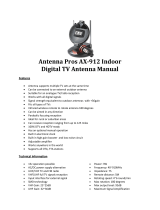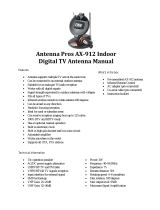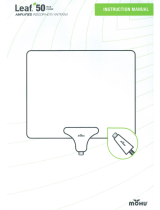
Troubleshooting guide
Still nothing? Did you run the channel scan?
The single most common overlooked step, and the most important, is doing a channel scan
through your television menu when setting up the antenna for the first time. If you move the
antenna to a new location to see if the reception is better you will need to run the scan
again. Each time you reposition the antenna you will need to do a scan until you find the perfect
location for reception.
In order for your antenna to perform you will need to do a channel scan so you can see what
channels you will be able to receive. After you connect your antenna to your television a
channel scan is the next step. This step can vary greatly since there are so many different
brands of televisions on the market, and no two are the same, you may need to reach out to
your specific manufacture for additional assistance. A google search with the brand of
your television followed by "customer service number" should locate their technical
support number. You may also be able to consult the owner’s manual for more detailed
instructions on how to run a channel scan.
Here are generic steps to do a channel scan:
You will need to run the “scan” function on your television set. This step can typically
be located by pressing the "menu" button on your remote and looking for "scan" or "set-
up".
You will also need to make sure that your television is set to "air" or "antenna" and not
cable.
The scan can take just a few seconds to several minutes depending on the number of
stations that the television is scanning for.
Once the scan is complete you should be receiving digital signals through your antenna.
If you need help figuring out how to run the channel scan on your television, please reach
out to your television's manufacture for assistance. They will be quickly able to walk you
through the channel scan process. If once you have the channel scan completed you are
still experiencing issues with your antenna please reach out to Mohu.
Can I use an antenna at my location?
There are many sights that you can use to see if you are in a good location for reception. We
suggest that you send us your complete address to [email protected] or call 855-446-6648
(M-F 8am-5pm EST) so one of our antenna experts can do a detailed analysis for you

I am not getting the channels the signal locator said I would!
Our site tool on www.gomohu.com looks primarily for the distance between your zip code and
the TV towers. It does not take into consideration if there are terrain issues such as hills,
mountains and/or valleys which can impede signals from reaching you nor does it identify if the
signal is being transmitted in VHF or UHF.
We would like to offer to do an in depth signal scan to see what kinds of signals are available in
your exact area and to determine if the antenna you purchased is the right one for you. If you
would please submit a ticket at [email protected] and provide us with your street address
and zip code we can do a detailed analysis of the signals you can expect to receive at your
address. We can also help you trouble shoot once we determine that you are in a good area to
receive signals. We are also reachable by phone at 855-446-6648 (M-F 8am - 5pm EST).
Can I be too close to my TV towers?
An issue that can sometimes occur when you are using an amplified antenna is poor reception
when you are very close to the transmitting towers. The signal from the tower can overpower the
amplifiers on over-the-air antennas and they won't work with the amplifier on them.
To resolve, we would recommend removing the amplifier and re-scanning for channels. Other
customers with a similar situation to yours have had success with this.
Which Way Are the Signals Coming From?
While our antennas are multidirectional it helps immeasurably to have the flat face of the
antenna pointed in the direction of the towers so that the signals have as much surface to "land
on", so to speak, as possible. While the sides of our antennas will pull in signals it's a pretty
small area for signals to try and "land". Think of an antenna like a tennis racket. You COULD
use the sides of the racket to hit the ball but you'd have much more success using the webbing as
the designer had intended.
Many site tools will allow you to enter in your complete address so you can get a general idea of
which way to point your antenna. Always use your complete address so that the information is
specific to your location. Even a move of a few inches can make a huge difference with
reception.
Why can't I get channels 2 through 13?
Our antennas have a digital VHF and a digital UHF range that vary based on the style of the
antenna.

Since 90% of the towers in the US are transmitting in digital UHF most digital antenna
companies design their antennas to pull in those signals most efficiently. There are still a few
towers that are transmitting in VHF and that can be a little more challenging. VHF signals are
always numbered 2 - 13 so if you are getting all the stations that are listed in your area with the
exception of a station with one of those number they are transmitting in VHF and you may need
a larger antenna. Here are the UHF and VHF ranges for our antennas.
Leaf Metro and Leaf Mini: 25 mile digital UHF range / 10 mile digital VHF range
Leaf 30, ReLeaf and Curve 30: 30 mile digital UHF range / 10 mile digital VHF range
Leaf 50 and Curve 50: 60 mile digital UHF range / 20 mile digital VHF range
Sky 60/Leaf Glide: 75/65 mile digital UHF range / 45 mile digital VHF range
One thing that some people do to be able to pull in the VHF stations that they desire but are not
able to get with their digital antenna is add a set of rabbit ears to their set up. Using an A/B
switch allows you to connect two antennas to your TV. The Mohu antenna for the digital UHF
and digital VHF signals that are in range and the rabbit ears for the VHF signals that are out of
our antenna's range. You would "switch" from A to B depending on what channel you were
wanting to watch at the time. It can be cumbersome but it is a way to get the channels you'd
hoped for. Here's a photo of an A/B Switch for reference and they can be purchased at any
retailer that sells electronics.
-
 1
1
-
 2
2
-
 3
3
Mohu Leaf Metro User guide
- Type
- User guide
Ask a question and I''ll find the answer in the document
Finding information in a document is now easier with AI
Related papers
Other documents
-
Hathaway BG2344 User manual
-
UBISHENG U-003 User manual
-
RCA ANT3037X User manual
-
KYOCERA NS-L37Q-10A User manual
-
Winegard A3-2000 Operating instructions
-
RocketFish RF-ANT50US Long-range Outdoor Antenna Quick setup guide
-
Uniden BCD536HP User manual
-
 Antenna Pros AX-912 User manual
Antenna Pros AX-912 User manual
-
 Antenna Pros AX-912 User manual
Antenna Pros AX-912 User manual
-
Uniden BCD436HP Owner's manual











